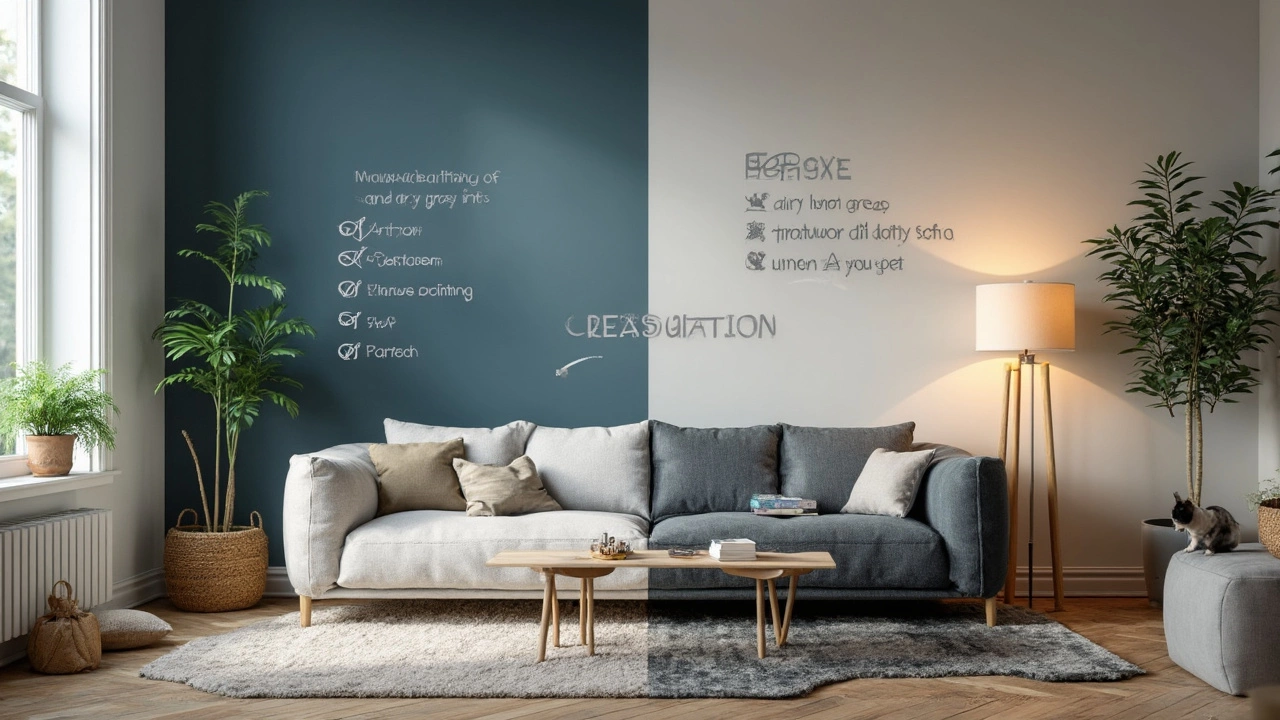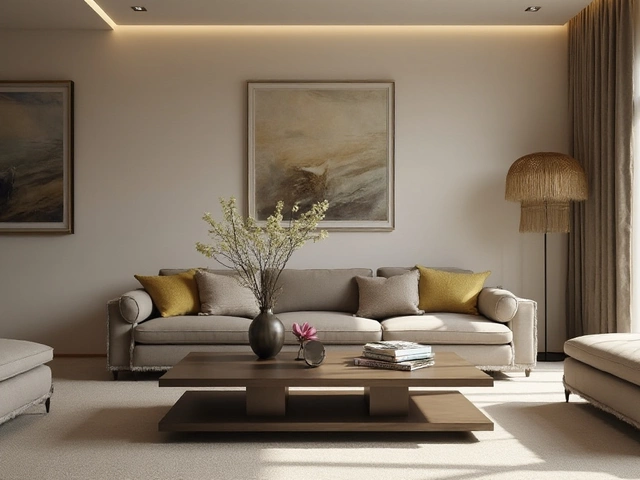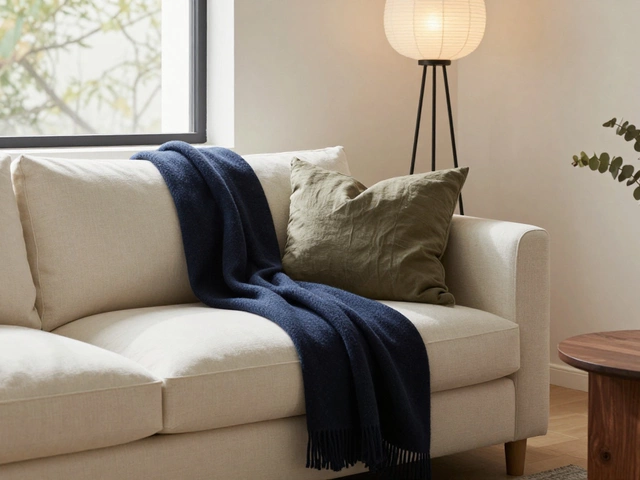
Ever noticed how a sofa can totally change the mood of a room? That color choice isn’t just about what goes with your throw pillows—it's about how you feel when you walk in every day. And let’s be honest: swapping out a sofa isn’t cheap or easy, so you want to get it right the first time.
One of the biggest questions out there—should your sofa be lighter or darker than your walls? There’s no single answer, because it depends on things like the natural light in your space, the size of your room, and whether your pet (looking at you, Jasper) is going to leave fur all over the place. The right move can make a small space feel open or give a big room some cozy vibes.
If you're trying to keep things modern and effortless, the color balance between your sofa and walls isn’t just a detail—it’s a power play. Plus, there are a few truths designers don’t always mention, like how dark sofas are way less stress when you love pizza nights or have a wild toddler tearing around. Ready for some real talk? Let’s break down the pros and cons to help you pick like a pro.
- Why Sofa and Wall Color Matter
- The Case for a Lighter Sofa
- Going Bold with a Darker Sofa
- Real-Life Tips and Common Mistakes
Why Sofa and Wall Color Matter
People will say, “It’s just a couch, chill!” But honestly, the color of your sofa stacked up against your wall color can make or break your living room vibe. The combo sets the stage for everything—how big the room feels, how chill or dramatic the space looks, and even how easy it is to keep things looking clean. According to a sofa color trends survey from 2024, over 65% of homeowners admitted picking the wrong color made their space feel off for years. That’s money and comfort down the drain if you don’t think it through.
There’s psychology too. Lighter colors usually open things up, making small or dark rooms feel airier. Darker shades, on the other hand, add depth and coziness, but sometimes shrink things visually. The trick is balance. When the tones of your sofa and walls clash or blend too much, it ends up either boring or overwhelming. There’s no one-size-fits-all, but there are smart ways to guide your pick.
As Sarah Sherman Samuel, a well-known interior designer, puts it:
“Color is the first thing anyone notices in a room. The right contrast between your sofa and walls can make your space feel intentional and pulled together—even if the rest of your stuff is a random mix.”
Your daily life matters, too. Got a tiny apartment or a big open-concept space? Do you eat on the sofa or have pets that shed? These things should steer your choice. Here’s how wall and sofa colors usually play out, based on data from recent home design surveys:
| Color Combo | Room Effect | Who Should Try It |
|---|---|---|
| Light Sofa + Light Walls | Makes small spaces look bigger; feels clean | Small rooms, low-light apartments |
| Dark Sofa + Light Walls | Adds drama; sofa becomes a statement | Modern lofts, families with kids or pets |
| Light Sofa + Dark Walls | Lively and modern; keeps contrast | Anyone who wants bold but light feel |
| Dark Sofa + Dark Walls | Super cozy but can feel smaller | Large spaces, reading nooks |
Remember, there are other wildcards: room lighting, floor color, art, and rugs. But your sofa-wall combo is the big ticket. So spend time sampling swatches, test in daylight and at night, and don't just trust how it looks on a screen. The reality can be way different.
The Case for a Lighter Sofa
Light sofas aren’t just a trend for magazine spreads—they actually pull their weight in making a living room feel bigger, fresher, and more modern. If you have darker or mid-tone walls, a lighter sofa is basically a cheat code to open up your space visually. It reflects more natural and artificial light, giving your room that airy, elevated vibe that’s kind of hard to mess up.
Here’s a simple truth: light sofas blend better with just about any color scheme. Got ever-changing taste or love to swap out your decor with the seasons? A lighter sofa, like soft beige, classic gray, or warm ivory, is a real team player. Those colors rarely clash and keep you from getting “locked in” to a bold color mistake you regret six months later.
Practicality counts too. A common worry is stains—and yeah, a white sofa and a bottle of ketchup might stress you out. But thanks to performance fabrics, lighter sofas are way more kid- and pet-friendly these days. Microfiber and stain-resistant blends make cleanup less of a nightmare, and slipcovers let you toss the mess in the wash. I can personally vouch that fur from my cat Jasper is less visible on pale gray than navy or chocolate brown.
If you still wonder, here’s some real data. According to a 2023 home interiors survey, 61% of interior designers said they’d pick a lighter sofa for spaces under 300 sq. feet, mostly to trick the eye and make the area look less cramped. The same study found that lighter sofas tend to stay on trend for almost twice as long as their bold, dark alternatives.
| Lighter Sofa Pros | Lighter Sofa Cons |
|---|---|
| Makes rooms look fresh and spacious | Can show stains if not using modern fabrics |
| Fits with many styles and seasonal looks | May need more frequent cleaning |
| Keeps home looking modern longer | Less contrast in all-white rooms |
| Cat and dog hair less noticeable (on pale gray/tan) | Some people find them "too safe" |
Thinking about resale? Lighter sofas also appeal to more buyers if you’re planning to move soon or sell furniture later. So, if creating a flexible, breezy space is your goal, and you want a setup that can keep up with your style changes (or your pets), a lighter sofa is tough to beat.

Going Bold with a Darker Sofa
Picking a dark sofa can make your living room look sharp and modern—think navy blues, deep greens, smoky charcoals, or even classic black. If you want a bit of drama or that cozy, 'curl up and watch a movie' vibe, this is your best bet. The main thing to remember: a dark sofa pulls the eye and acts like the anchor of your space.
Here’s a cool fact—interior designers often use a dark sofa color to ground open-plan rooms or big living spaces. The deep tone keeps the sofa from fading into the background, especially if your walls are on the lighter side, like soft greys or off-whites. Plus, dark colors handle real life better: pizza stains, coffee spills, and yes, Jasper’s fur, don’t show up as much (unless he’s a white floof, then you’ll notice).
If your place gets a ton of sunlight, dark sofas can fade over time, but most modern fabrics are built to handle it. Still, you might want to keep them out of direct beams or pull blinds on super bright days. And don’t forget, darker shades can shrink a tiny room visually—they soak up light rather than bounce it around. But if your room is big, that’s actually an advantage. The sofa stands out instead of getting lost.
Here’s the breakdown on the perks and drawbacks:
- Perks: Hides stains and wear, adds contrast to light walls, feels cozy, looks stylish and timeless.
- Drawbacks: Can show lint or pet hair from light-colored animals, could make small rooms feel tighter if there’s not enough light, fades in direct sun if unprotected.
Real people say they worry less about mess with a dark sofa. One survey in 2024 (by a major home store) found that 69% of families with kids or pets chose dark sofas for this exact reason. Check out how different wall and sofa combos work in real rooms:
| Wall Color | Dark Sofa Effect | Best For |
|---|---|---|
| Off-white/Light Gray | High contrast, modern look | Open, sun-filled spaces |
| Deep Blue/Olive | Cohesive, moody vibe | Reading nooks, cozy dens |
| Warm Taupe | Grounds the room, subtle contrast | Family rooms, neutrals fans |
If you want to really pop a dark sofa, toss on some textured light cushions or a bright throw. It adds just enough balance so things don’t get gloomy. And don’t stress—if you get bored later, the sofa’s solid base works with bold new accent colors any time you want a refresh.
Real-Life Tips and Common Mistakes
Here’s where things get real. A lot of people shop for a sofa by color alone, but that’s just step one. You want a vibe that actually works day after day, not just a pretty Instagram pic. So let’s get down to brass tacks and avoid some classic mistakes.
- Don’t ignore your lifestyle. If you’ve got pets (Jasper knows what I mean), toddlers, or you just love snacks on the couch, light-colored sofas make every crumb and fur strand way more obvious. Darker shades can hide wear, spills, and fur, and need less panic-cleaning. But—remember—darker fabrics can also show dust and lint, especially in direct sunlight.
- Test the lighting. Samples sometimes look perfect in-store but shift in your living room. Grab some color swatches and check them morning, noon, and night. A color that pops in bright daylight can totally flatten out when the sun goes down.
- Watch your room size. If your space is tight, a dark sofa against dark walls can make things feel cramped. A lighter sofa will open things up and bounce light, while a dark sofa in a big, bright room can add coziness and some drama.
- Think about maintenance. White or very pale sofas look fresh on day one—but one coffee spill or a couple of Jasper’s muddy paw prints and you’re reaching for the stain remover. Performance fabrics are getting better, but nothing is totally immune.
- Visual flow matters. If your sofa is too close in color to the walls, you risk everything blending into one big blob. A bit of contrast keeps the room lively. Interior designers suggest a 2-3 shade difference between the wall and sofa color for balance.
Got kids or pets? Here’s a quick cheat code: medium gray, blue, or brown sofas hide messes best. No wonder over 42% of modern sofa sales in 2024 used these shades, with mid-tone grays being the top pick for families and pet owners.
Here’s how typical sofa colors stack up in the cleaning and styling game:
| Sofa Color | Shows Stains | Shows Fur | Fits Modern Look |
|---|---|---|---|
| Light Beige | High | Medium (depends on pet color) | Yes |
| Mid-Gray | Low | Low | Yes |
| Deep Navy | Medium | High (shows light fur) | Yes |
| Dark Brown | Low | Medium | Yes |
| White | Very High | High | Yes |
The last mistake? Forgetting your accent pieces. Throw pillows and rugs can shift your color scheme without swapping furniture, so you don’t have to commit to wild colors on your main pieces. If you’re nervous, keep your sofa a neutral shade, then layer in personality with accessories you can actually afford to change.



